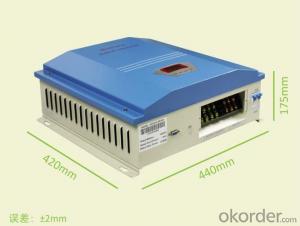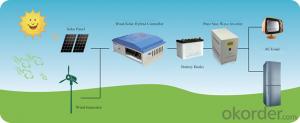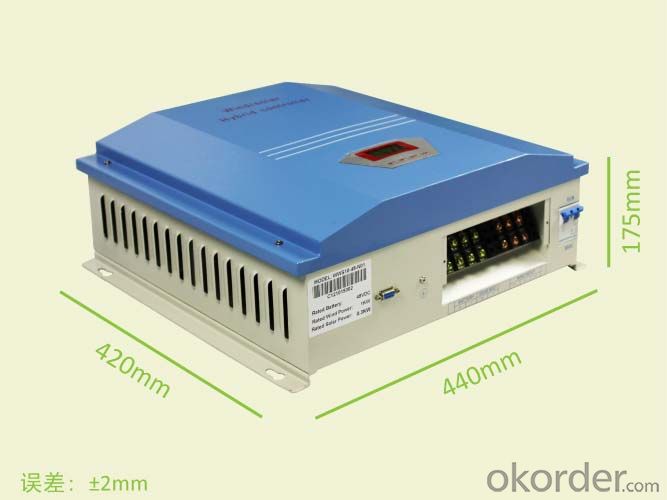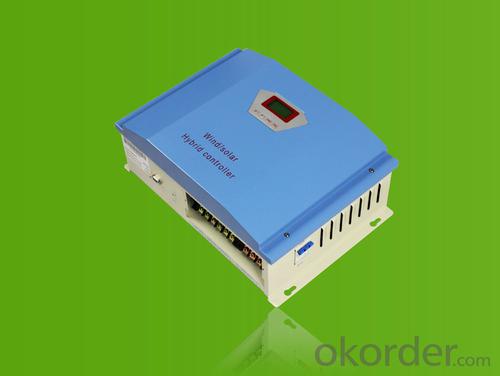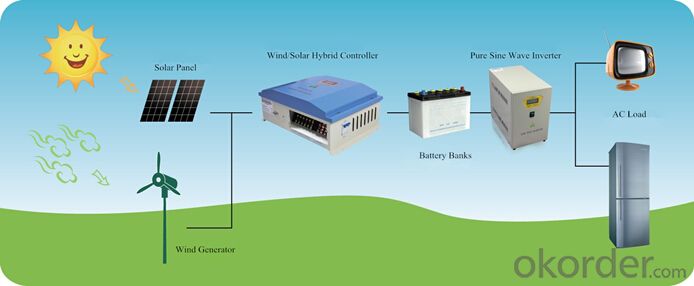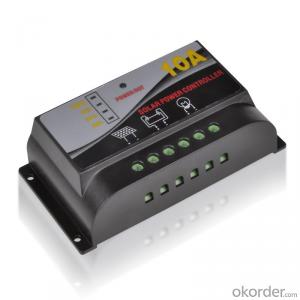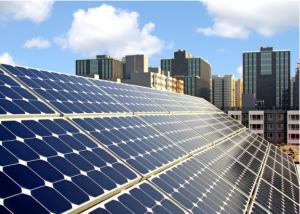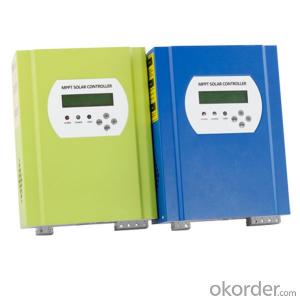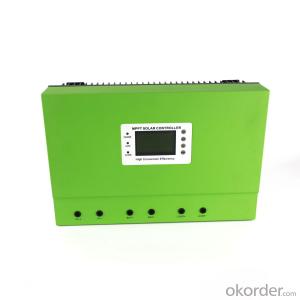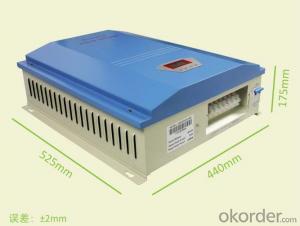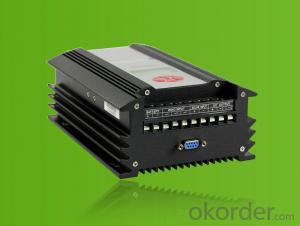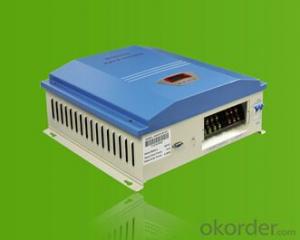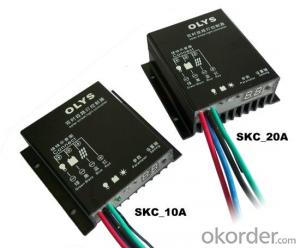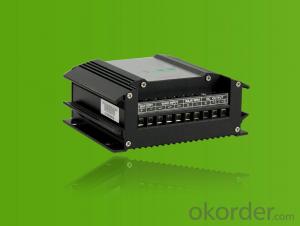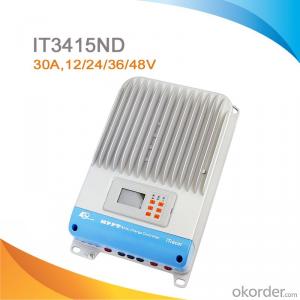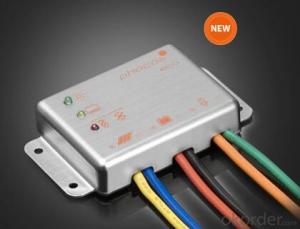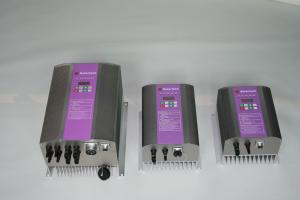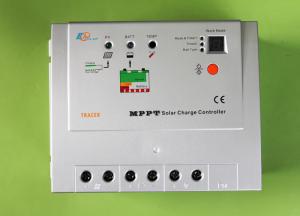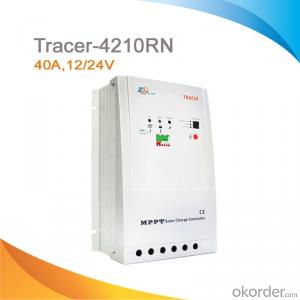Solar Street Light Controllers:2kW Wind Solar Hybrid PWM Stepless Unload Mode Controller
- Loading Port:
- Shanghai
- Payment Terms:
- TT or LC
- Min Order Qty:
- 1 unit
- Supply Capability:
- 5000 unit/month
OKorder Service Pledge
OKorder Financial Service
You Might Also Like
I. PRODUCT INTRODUCTION
The wind/solar hybrid controller is the control device which can control wind turbine and solar panel at the same time and transform wind and solar energy into electricity then stores to the battery bank.Wind/solar hybrid controller is the most important part in off-grid system, whose performance has much effect on life expectancy and operational stability of the whole system, especially the battery expectancy. Or battery service life will be shortened by over-charge or over-discharge.
II. PERFORMANCE FEATURES
Superior military-grade components to ensure the product stability.
Perfect protection function, thus the system has higher reliability.
Check and set all operation parameters as requirement from LCD display.
Voltage limiting and current-limiting charge mode ensures battery in the best charging status.
PWM stepless unload mode, which burn the excess power into dump load, making the battery charging in best status.
III. APPLICATION AREAS
Stand alone wind/solar hybrid power station; Stand alone domestic household wind/solar hybrid power system.
Mobile communication base stations, expressway and other non-residential regions.
Coastal islands, remote mountainous, border posts for regions shortage of or without electricity.
Government demonstration projects, landscape lighting project.
IV. 2KW TECHNICAL PARAMETERS
Product Model | WWS20-48 | WWS20-96 | WWS20-110 | WWS20-120 | WWS20-220 |
Rated Battery Voltage | 48V | 96V | 110V | 120V | 220V |
Rated Wind Turbine Input Power | 2kW | 2kW | 2kW | 2kW | 2kW |
Maximum Wind Turbine Input Power | 3kW | 3kW | 3kW | 3kW | 3kW |
Wind Turbine Brake Current | 42A | 21A | 19A | 17A | 10A |
Rated Solar Input Power | 0.6 kW | 0.6 kW | 0.6 kW | 0.6 kW | 0.6 kW |
Floating Charging Voltage | 58V | 116V | 133V | 145V | 266V |
Dimension(L x W x H) | 442×425×172 mm | ||||
Net Weight | 11.5 kg | ||||
Display Mode | LCD | ||||
Cooling | Fan | ||||
Protection Level | IP20(Indoor) | ||||
Quiescent Current | ≤20 mA | ||||
Protection functions | Battery over charge; Battery over discharge; solar reverse charge protection; anti-reverse-connection protection; wind turbine over rotate speed protection; wind turbine over wind speed protection; wind turbine over voltage protection; wind turbine over current protection; manual brake protection; automatically brake protection; lightning protection. | ||||
Ambient Temperature | -20~+55℃ | ||||
Ambient Humidity | 0~93%,without condensing | ||||
Working Altitude | ≤4000m | ||||
In order to serve our customers better. Our company can adjust parameters configuration according to customer’s requirement. | |||||
- Q: How does a solar controller handle the protection against electromagnetic interference?
- A solar controller handles protection against electromagnetic interference by incorporating shielding mechanisms and filters to prevent unwanted electromagnetic signals from affecting its operation. These shielding mechanisms and filters help to block or reduce the impact of electromagnetic interference on the controller's circuitry, ensuring its proper functioning and minimizing any potential disruptions caused by external electromagnetic sources.
- Q: Can a solar controller be used with solar panel grounding systems?
- A solar controller can indeed be utilized alongside solar panel grounding systems. In fact, it is highly advisable to incorporate a solar controller as a vital component of the entire system. The primary role of a solar controller is to regulate the flow of charge from the solar panels to the batteries, thus preventing overcharging and increasing the lifespan of the batteries. Regarding solar panel grounding systems, their purpose is to establish a secure pathway for electrical current in the event of a fault or lightning strike. These systems generally consist of grounding rods, conductors, and bonding connections to effectively dissipate any excess electrical energy into the earth. Although the solar controller itself does not directly participate in the grounding system, as its primary function is to regulate the electricity flow, it is crucial to ensure that the solar panel arrays are appropriately grounded and bonded according to local electrical codes and standards. To summarize, a solar controller can be used in conjunction with solar panel grounding systems, as they serve different functions within the overall solar power system. It is essential to adhere to the appropriate guidelines and regulations to guarantee the safe and efficient operation of the entire system.
- Q: Can a solar controller prevent overcharging of batteries?
- Preventing overcharging of batteries is one of the key functions of a solar controller. Also referred to as a charge controller or regulator, it plays a vital role in a solar power system by regulating the voltage and current that flows from the solar panels to the batteries. Its primary purpose is to protect the batteries from overcharging, as this can result in reduced battery life and potential damage. The solar controller constantly monitors the voltage and state of charge of the batteries, making adjustments to the charging current as necessary. When the batteries reach full charge, the solar controller prevents any further charging by redirecting the excess energy generated by the solar panels. Typically, this is achieved by either reducing the charging current or disconnecting the panels from the batteries. In addition to its basic functions, some advanced solar controllers offer additional features such as temperature compensation and equalization charging. Temperature compensation ensures optimal battery performance and longevity by adjusting the charging voltage based on the battery temperature, preventing overcharging or undercharging in different environmental conditions. On the other hand, equalization charging is a controlled overcharging process that is performed periodically to balance the battery cells and eliminate sulfation, ultimately enhancing battery performance. In summary, a solar controller is an indispensable component in a solar power system that safeguards the batteries against overcharging. Its presence ensures the longevity and optimal performance of the batteries, making it an essential aspect of any solar setup.
- Q: How do I protect a solar controller from power surges or spikes?
- To protect a solar controller from power surges or spikes, you can use a surge protector or an uninterruptible power supply (UPS). These devices will help regulate the voltage and divert any excess power away from the controller, ensuring its safety and longevity. Additionally, it is recommended to install proper grounding and earthing systems to further protect against power surges or spikes.
- Q: Can a solar controller be used with solar-powered indoor communication systems?
- Yes, a solar controller can be used with solar-powered indoor communication systems. A solar controller is a device that regulates the power flow from the solar panels to the batteries, ensuring efficient charging and preventing overcharging. Even though indoor communication systems do not directly rely on solar power, they can still benefit from using solar panels to generate electricity and reduce their reliance on the grid. By integrating a solar controller into the system, it can effectively manage the power generated by the solar panels, ensuring optimal performance and longevity of the batteries. This setup allows for continuous operation of the indoor communication systems, even during power outages or in remote locations where grid power may not be available.
- Q: What are the advantages of using an MPPT solar controller?
- The advantages of using an MPPT (Maximum Power Point Tracking) solar controller include increased efficiency and power output from solar panels, the ability to charge batteries more quickly and effectively, and improved performance in low-light or fluctuating weather conditions. MPPT controllers can also provide real-time monitoring and data logging capabilities, allowing for better system management and maintenance. Additionally, MPPT controllers are generally more versatile and compatible with various types of solar panels and battery systems.
- Q: What is the role of a solar controller in preventing overcurrent in the solar panel system?
- The role of a solar controller in preventing overcurrent in a solar panel system is crucial for maintaining the safety and optimal functioning of the system. A solar controller, also known as a charge controller, is responsible for regulating the flow of current from the solar panels to the battery bank or electrical load. One of the main functions of a solar controller is to prevent overcharging of the batteries. Solar panels generate electricity from the sun, and if not properly regulated, they can produce more current than the battery bank can handle. This excess current can lead to overcharging, which can damage the batteries and reduce their lifespan. To prevent overcurrent, a solar controller monitors the voltage of the battery bank and adjusts the charging current accordingly. When the batteries reach their maximum voltage level, the solar controller reduces the charging current or completely disconnects the solar panels from the battery bank, preventing any further flow of current. This helps to maintain a safe and optimal charging level for the batteries, ensuring their longevity and performance. Furthermore, a solar controller also protects the solar panels themselves from overcurrent. In situations like partial shading, a phenomenon known as "hot spots" can occur, where certain sections of the solar panels receive less sunlight than others. This can lead to an imbalance in the current flow and cause overcurrent in those specific areas, potentially damaging the solar panels. Solar controllers are equipped with various protective features, such as overcurrent protection, short-circuit protection, and reverse polarity protection, to safeguard the solar panels from these issues. They constantly monitor the current flow from the panels and disconnect them if any abnormalities are detected, preventing any potential damage. In summary, the role of a solar controller in preventing overcurrent in a solar panel system is to regulate the charging current to the battery bank, preventing overcharging and damage to the batteries. Additionally, it protects the solar panels from overcurrent and potential damage caused by shading or other irregularities. This ensures the longevity, safety, and optimal performance of the solar panel system.
- Q: Can a solar controller be used with flexible solar panels?
- Yes, a solar controller can be used with flexible solar panels. Solar controllers are designed to regulate the charging process of solar panels, regardless of their flexibility. As long as the flexible solar panel is compatible with the solar controller's voltage and current ratings, it can be used effectively.
- Q: What are the safety precautions when installing a solar controller?
- Some safety precautions to keep in mind when installing a solar controller include: 1. Ensure that the solar controller is installed and operated in a well-ventilated area to prevent overheating. 2. Prior to installation, always disconnect the solar panels and batteries from the system to avoid potential electrical shock or damage. 3. Use proper safety equipment, such as insulated gloves and safety glasses, when working with electrical components to minimize the risk of injury. 4. Ensure that all connections are tightened properly to prevent loose connections or electrical arcing. 5. Follow the manufacturer's instructions and guidelines for installation, as each solar controller may have specific requirements. 6. Turn off all power sources before making any adjustments or modifications to the solar controller. 7. Regularly inspect and maintain the solar controller to identify any potential issues or malfunctions that may compromise its safety. 8. If unsure about any aspect of the installation process, consult a professional electrician or solar technician for guidance and assistance.
- Q: What is the maximum distance a solar controller can be placed from the batteries?
- The maximum distance a solar controller can be placed from the batteries depends on the specific model and its design. In general, the distance should be minimized to reduce voltage drop and ensure efficient charging. It is recommended to consult the manufacturer's specifications or guidelines for the specific solar controller being used to determine the maximum distance allowed.
Send your message to us
Solar Street Light Controllers:2kW Wind Solar Hybrid PWM Stepless Unload Mode Controller
- Loading Port:
- Shanghai
- Payment Terms:
- TT or LC
- Min Order Qty:
- 1 unit
- Supply Capability:
- 5000 unit/month
OKorder Service Pledge
OKorder Financial Service
Similar products
Hot products
Hot Searches
Related keywords
